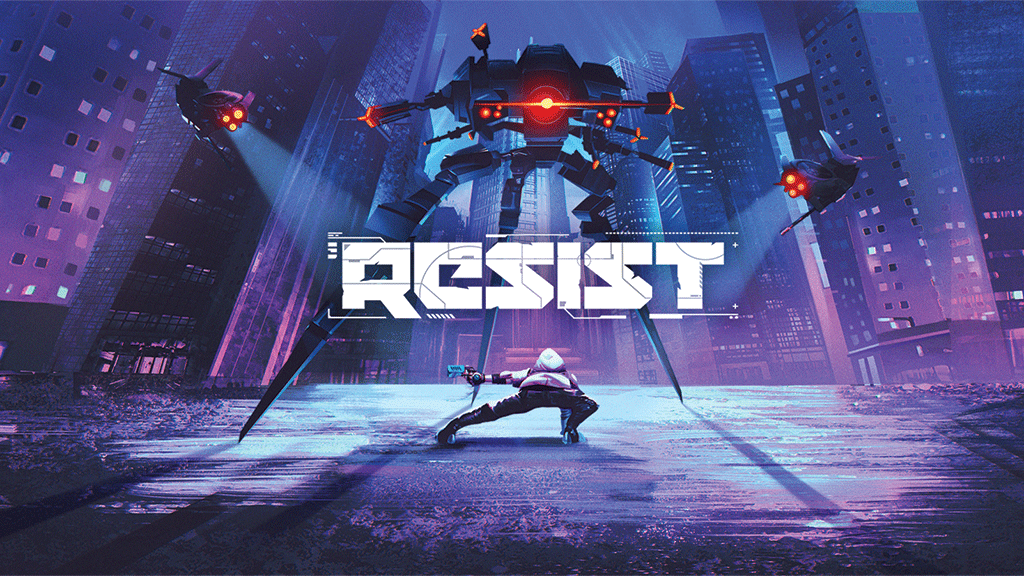
by Victor Lucas, creator and host, The Electric Playground
“Oh my god!” I involuntarily yelped in my living room at 10 p.m., well past our daughter’s bedtime. My wife heard me upstairs, but thankfully my kiddo didn’t wake up to my virtual reality (VR)-induced exclamation of sheer terror. I was playing Resist on the Oculus Quest 2, and up until that point, the game had felt like a regular, first-person espionage experience in VR. The game was asking me to stealthily ascend a skyscraper on window-washer elevators and eavesdrop on an unsuspecting executive. No problem, I thought, I’ve played games like this before. I had been walking, climbing, and interacting with levers and buttons — standard VR fare.
But then something wild happened. I was dozen of stories up in the air on my rickety platform, swaying in the breeze of the altitude, when the girders I was supposed to walk toward suddenly gave out and tumbled to the sci-fi world below. The voice in my head said that I had to jump to the next platform, which looked like it was 40 feet away. I went sailing high into the air and overshot my landing. My heart was racing and my palms were instantly slippery with sweat. My body and my brain were freaking out as I plummeted toward the hyper-clean pavement of the city I would die in. “Oh my god,” indeed.
That’s the unmistakable power of VR. The program is so good, it can be hard to distinguish between what’s virtual and what’s real. Things in Resist only improved from there. Before long, I was swinging through the city with the kinetic grace of Spider-Man, all the while blasting at nasty little drones that had been sent out to pick me off in mid-air. What an incredibly thrilling experience.
Resist, developed and published by The Binary Mill, was released on the Oculus Quest platforms last November. Despite the game’s critical success, most people have never heard of Resist and only a very tiny group of players have tried it. It’s a shame, but obscurity is still the reality of virtual reality.
HUMBLE BEGINNINGS
Although it can be hard to gain notoriety, the VR community is changing — and quickly. Meta — previously Facebook — has a certified hit on their hands with the Oculus Quest 2 platform. The platform is a standalone VR device released in 2020 with an impressive assortment of features combined with a price point that makes it all but irrefutable for anyone interested in VR entertainment, starting at just $299. So far, it is the closest that VR has come to entering the mainstream. There are hundreds of exhilarating moments waiting for anyone willing to leap into this magical medium right now.
“My heart was racing and my palms were instantly slippery with sweat. My body and my brain were freaking out as I plummeted toward the hyper-clean pavement of the city I would die in. ‘Oh my god,’ indeed.”
— Victor Lucas, creator and host of “The Electric Playground”
Currently, there are about a half dozen viable VR platforms on the market. Each platform adds its own wrinkle to the VR experience and lands at a different price point. Almost all other current VR options besides the Oculus Quest 2 will require players to be physically tethered to another device, like a gaming console or a powerful PC, which, of course, adds tot he cost to get started. Playing tethered VR after engaging in a wireless experience is, in a single word, lame. Best to keep that in mind.
Playstation VR (PSVR) was released about a half decade ago for Sony’s previous gaming console, the PlayStation 4. It’s a tethered option that will connect to the current PS5 with a dongle, and although it shows its age technologically, it still has a bountiful collection of great titles that are fun to play. Games like Star Wars Squadrons, Resident Evil 7, Astro Bot Rescue Mission, Moss, Blood & Truth, Iron Man VR, and VR stalwarts like Beat Saber and Pistol Whip are all superb on the PSVR. And, Sony recently announced a new system called the PSVR 2, which will bring an enhanced VR experience to the PS5 and could potentially be out in time for the holiday season.
For those wanting to jump into a premium VR experience with higher fidelity visuals and superior controls, you’d be spending considerably more money for a PC VR solution like the Valve Index. This system — which sells for about $1,000 with all its bells and whistles — offers screen tech with a wide field of view and innovative controllers called knuckles, which offer full-finger tracking. Valve has also developed and published a state-of-the-art VR game called Half-Life: Alyx, which runs beautifully on the Index.
However, the Index system requires base station motion sensors that are a pain to set up, but create sophisticated room-scale immersion. Its downside? The Valve Index is, unfortunately, tethered. Disappointed emoji face.

STRAPPING ON HEADSETS IS SO META
The Oculus Quest 2 might be the best VR console on the market, but it’s not perfect. For starters, the device uses a versatile, but fairly anemic, Qualcomm Snapdragon XR2 SOC processor with 6GB of RAM, meaning that although the system can run software at 120 frames per second, the graphic output of the device is years behind what more advanced PC tethered systems offer. Oculus also conducted a voluntary recall on the foam facial interface for the device because it created skin irritation on some users.
Additionally, the Quest 2 has speakers built into the headset that don’t cover your ears — instead of having the sound envelop them, players have audio projected at them. Consequently, diehard fans of the Quest 2 often upgrade their device with a better, more comfortable eyepiece, a better head strap, extra battery power, and Bluetooth headphones. All of these add-ons can drive the total investment for the Quest 2 to almost double the price of the base system. Despite its faults, the Quest 2 is a great starting point for this next generation of virtual reality.
It’s also clear that the best VR systems of the future will not hamper us with superfluous cables. The VR headsets we crave must be light on our faces, do less damage to our hairstyles, and treat our skin better.
Meta has a new, untethered, high-end, and high-priced VR option that the company has codenamed Project Cambria. Meta founder Mark Zuckerberg described the device at the company’s Connect event last fall: “This isn’t the next Quest. It’ll be compatible with Quest, but Cambria will be a completely new, advanced, and high-end product. And it’ll be at the higher end of the price spectrum, too.”
The emphasis this time will be on more sophisticated sensor technology, like full-face tracking to create enhanced social interactivity. With the advanced cameras on the device, this headset will blur virtual reality with our physical reality to create some stunning augmented reality (AR) opportunities. As Zuckerberg pointed out, “Imagine working at your virtual desk with multiple screens while seeing your real desk so clearly that you can pick up your pen and write notes without taking your headset off.”
Project Cambria is designed to seamlessly onboard users into Meta’s highly publicized, incredibly well-funded, and much maligned metaverse. Zuckerberg and his investors will be spending billions to create a new, 3D evolution of what the world today knows as the internet.
The metaverse is being designed — with the usual cascade of buzzwords and promises — as a virtual world created for our digital avatars to experience in a more visceral way than most of us can even comprehend right now. The closest reference to what we can imagine a metaverse looking like is Steven Spielberg’s Ready Player One, which is based on Ernest Cline’s very entertaining and prophetic novel. In the story of Ready Player One, a digital world called the Oasis replaces humanity’s desire to live in the real one. Almost every point of human contact takes place within the Oasis because people don’t want to connect IRL anymore. It’s terrifying.

A BATTLE IS BREWING
The metaverse, by definition, cannot be owned by Meta. Indeed, there are numerous competitors and potential collaborators in the “metaverse” marketplace. Zuckerberg and his colleagues are currently facing a trademark challenge for the name Meta from the Meta PC Company based in Arizona that had already trademarked the name before Facebook’s high-profile rebrand. In fact, even the term “metaverse” is borrowed. The name and the concept surrounding the metaverse was coined by science fiction author Neal Stephenson in his 1992 book Snow Crash.
“The metaverse is being designed — with the usual cascade of buzzwords and promises — as a virtual world created for our digital avatars to experience in a more visceral way than most of us can even comprehend right now.”
— Victor Lucas, creator and host of “The Electric Playground”
The metaverse is still largely unknown: There are elements surrounding it that are unquestionably discomforting, particularly with concerns to our individual data and privacy. Meta still has a lot to answer for before we strap on headsets and explore its new virtual playground.
One of the competitors in this race to define the future of virtual reality may be Apple. Although we have seen VR and AR products from companies like Google, Samsung, and Microsoft, we have not yet seen a dedicated headset from Apple. Many are predicting that this is about to change, pointing at the company’s sizable investments into AR-enhanced software for its iPhone as a good indicator. Apple has also been on a tear over the last several years, enhancing its privacy protocols to the detriment of Meta’s advertising earnings. As many know, the two tech giants have an adversarial relationship that seems to be extending into the VR realm.
So what would an Apple-branded VR/AR headset do for this burgeoning sector of interactive entertainment? In a word or two: explosive propulsion. Apple spends a fortune on researching and developing its user experience. Its products don’t always succeed, but the company rarely looks or feels less than premium. The brand loyalty that Apple enjoys is the envy of the entire consumer electronics industry. If Apple jumps into this battle for our VR attention, things are going to get very, very exciting in this space. One could almost say, “Oh my god!”
This article was originally published in Issue No. 12 of the Pop Insider. Click here to read the full issue!

